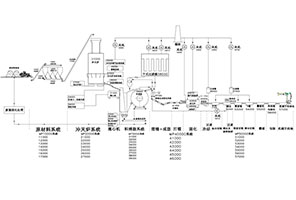An Introduction to our Rockwool Board:
AAdvantages of Rocktec Rock Wool
1. No slag -- Real rock wool (main raw materials: basalt, dolomite, and coke) Over 1.8 ph, high durability, and has excellent water and temperature resistance
2. The maximum pleating coefficient can reach 1:4 -- excellent tensile and compression resistance
3. Precise automatic control -- the process parameters of the production line are automatically controlled and adjusted by the central control system, avoiding the untimely and unstable manual adjustment ensuring the consistency of product quality.
4. Unique surface pattern – beautiful and difficult to counterfeit
5. Versatile product series - can be widely used in buildings external insulation systems, curtain walls, composite wall systems, roof insulation systems, rock wool sandwich boards, industrial insulation and other fields.
6. The whole product line was imported from ENETEX Co., Ltd. Germany and assembled with the help of technical professionals. The only production line in China using entirely imported parts.

Characteristics
Insulation: the fiber of Rocktec is slender, flexible, and has low thermal conductivity, and can improve the thermal resistance of the building envelope, improving energy efficiency and conservation.
Acoustic noise reduction: Rocktec’s porous rock wool fiber structure provides efficient acoustic noise reduction as well as elastic damper physical characteristics which protects the wall from damage and breakage.
Fire Protection: Rocktec’s A1 fire rating means it has a melting point higher than 1000 ° C and that it will not burn below 1000 ° C. Rocktec does not release heat and toxic fumes, can block the spread of flames, and has high dimensional stability, without deformation in the event of a fire.
Hydrophobic and moisture resistance: Rocktec’s hydrophobic rating reached 99%; has extremely low water absorption rate, no capillary permeability, and does not suffer the effects of non-hygroscopic aging.
Non-corrosive: Rocktec itself is chemically stable, neutral or weak alkaline, which results in no corrosion of carbon steel, stainless steel, aluminum and other metal materials.
Health and environmental protection: Rocktec rockwool board in the long-term use does not rot, mildew, and is bacteria-free. Rocktec does not contain asbestos, or CFC chlorofluorocarbons /HFC Trifluoromethane, HCFC HCFC-141b and other harmful substances.
Dimensional stability: Over time, Rocktec does not bend or deform and can be used as an enduringly stable substrate material, ensuring a high standard of water-proofing. It is also resistant to adverse substrate stress.
Stable performance: Rocktec has a high compressive strength and tensile strength ensuring long-term stability and reliability of the product’s performance and its components.
The production process
1. Raw material system Raw materials consist of basalt, dolomite and coke (the line does not use any slag). They are fed by forklifts and fed in batches through belts into the cupolas.
2. Cupola system As the raw materials are filled into the cupola, the basalt and dolomite gradually melt. The molten rock liquid flows out through the siphon on the cupola’s side and through the adjusted runner onto the roller of the spinning machine.
3. Spinning system Under a strong spinning force, the molten rock liquid is blown by a roller into a fuse with a diameter of 3-5 microns. Meanwhile, phenolic resin, a hydrophobic agent, and dustproof oil are prepared by the glue spraying system and are ejected from the nozzle around the roller of the spinning machine. Then they are evenly sprayed on the surface of the fiber.
4. Drum system The fiber, blown by the spinning machine from the wind system, falls into the drum through the chamber. With the rotation of the drum, the fiber is continuously absorbed by negative pressure on the grid on the side of the cotton accumulation drum, forming a blanket.
5. Pendulum and forming system Once the blanket is between the pendulum’s two belts, and it has fallen from the top under two belts, the pendulum swings back and forth along the direction of the blanket. In this way, the blanket is put on the molding belt layer by layer. By adjusting the speed of the molding belt, the rock wool blanket can be formed with varying densities.
6. Pleating system After entering the pleating machine, each layer of rock wool blanket becomes folded through the relative movement of the lower roller on the pleating machine, forming an m-shaped structure and increasing the strength between the layers.
7. Curing system The rock wool blanket enters the curing oven from one end, and after being compressed and heated by the curing oven in sections, it comes out from the other end of the curing oven.
8. Cooling system After coming out of the curing oven, the rock wool blanket has a high temperature and needs to be pumped to cool down. After cooling, it can be further processed.
9. Longitudinal cutting The cooled rock wool board is cut into different widths and lengths as required.
10. Trimming and scrap crushing The edge of the rock wool board coming out of the curing oven is uneven and needs to be cut off and trimmed. The cut edge falls into the pulverizer and the pulverized powder is sucked into a dust collecting system.
11. Crosswise cutting A dust free saw is then used to cut the rock wool board into the required sizing through a crosswise cutting procedure. Similarly, there is suction around the cutting saw that inhales dust generated by cutting the board.
12. Stacking The cut rock wool board needs to be folded into a pile after packaging. The automatic stacking machine can manage the automatic stacking of the rock wool board.
13. Packaging Each stacked rockwool board will be covered with PE film by the thermal shrinkage packaging machine. It then enters the heating oven, is blown by hot wind, undergoes PE film contraction, leaving a pack of rockwool board that is well wrapped up.

Langfang Xiangda thermal insulation material


